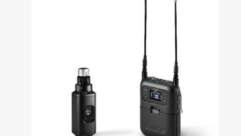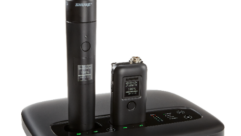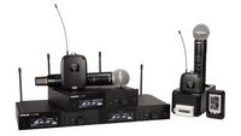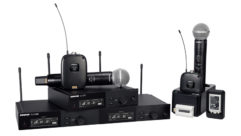
Shure SLX Wireless Microphone Systems
Jan 1, 2005 12:00 PM,
By John McJunkin
Mix and match components to enhance sound quality for a variety of applications.
Shure has introduced a new line of SLX wireless systems, which offer solutions for a number of uses, including handheld, head-worn or lavalier mics as well as musical instrument applications. I test drove a kit consisting of an SLX4 receiver, an SLX2/SM86 handheld mic, a Beta WBH53B head-worn mic, and a WL50B lavalier mic. An SLX1 body-pack transmitter was included with the receiver for use with musical instruments and the head-worn and lavalier mics.
SLX4 receiver and SLX1 body-pack transmitter
THE TRANSMITTERS
The SLX2 handheld transmitter takes two AA batteries. It utilizes Shure’s proprietary Audio Reference Companding, which compands only at high SPLs. This reduces “breathing,” yielding a greater dynamic range. I found that, as Shure claims, the extended headroom created by this system diminishes the likelihood of clipping. This compansion scheme was transparent, with obviously low compression and expansion ratios. This wireless system sounds more like a wired mic.
The SLX2 features an LCD display to show group and channel numbers and remaining battery strength. It also indicates whether the mic is locked (prevents manually changing the settings) and the use of master list frequencies (not adjustable by the transmitter). The display can also indicate if the transmitter and receiver are set to incompatible frequencies. In this case, it is necessary to synchronize the frequencies using the infrared transceiver, which is accessible by screwing off the bottom of the microphone.
The SLX1 body-pack transmitter ($283.66) also features Audio Reference Companding, yielding superior results for head-worn and lavalier mics and musical instrument applications. The SLX1 has the same LCD display and function as the SLX2 transmitter and similarly requires two AA batteries. To accommodate most applications, three gain levels are available: mic level, 0dB, and -10dB. Like the SLX2, the RF output is 30mW, yielding a range of about 100m. This should be plenty for most venues. The published frequency range for both of these transmitters is 45Hz to 15kHz, with THD at <0.5% and dynamic range rated at >100dB, A-weighted. The SLX1 also has an IR transceiver for frequency synchronization with the wireless receiver.
THE MICS
The SLX2/SM86 ($384.04) is a combination of an SLX2 transmitter and an SM86 mic, which is a handheld electret condenser mic intended for vocals. Beta87A, Beta87C, Beta58A, and SM58 options are available as well. The SM86 has a cardioid pickup pattern and, being a condenser, handles transients well. The mic exhibits a frequency range of 50Hz to 18kHz, with a healthy 6dB bump at about 8kHz to enhance clarity. The published dynamic range of this mic is 124dB, which is the maximum A-weighted SPL. Its signal-to-noise ratio is 71dB at 94dB SPL. It’s nice and quiet, with self-noise rated at 23dB, A-weighted. The mic’s tight pattern helps reduce feedback, yielding a superior sound quality for both speech and singing. A -10dB pad can be inserted to manage the sound if necessary.
The Beta WBH53B ($509.65) is a head-worn, omnidirectional electret condenser mic intended for use with an SLX1 transmitter. It wraps behind the head with soft earforms and a non-reflective wireframe that allows the mic to be positioned on either side. The boom can be twisted to position the mic, but it doesn’t require much futzing. To increase camouflage, the mic is available in black or tan.
The frequency response is quite flat, with the exception of a healthy 10dB bump at about 13kHz with the standard protective cap. That bump can be reduced to about 3dB with the filtered protective cap. It’s nice to have both options available to meet the needs of your application. The published range of the mic is 20Hz to 20kHz. Self-noise is a bit higher than the handheld at 39dB, yielding a signal-to-noise ratio of 55dB at 94dB SPL. This mic can take significant SPL — up to 142dB — with THD at 1%. The WH30TQG head-worn mic is also available for use with this system.
The WL50B ($316.16) is an omnidirectional electret condenser lavalier mic that’s useful for theater, television or film, and event production. It’s small (5.8mm × 11mm) and visually unobtrusive. It’s available in black, tan, or white, and it ships with a swiveling lapel clip, a dual tie clip, a pin mount, and a magnet mount. It can handle 133dB SPL at 1% THD, and its published frequency range is 20Hz to 20kHz. Its self-noise is rated at 30dB, yielding a signal-to-noise ratio of 64dB at 94dB SPL. Two equalizations caps are included: the “mild boost,” which yields a boost sloping up to about 5dB centered at around 13kHz; and the “high boost,” which achieves a greater boost for increased clarity of around 10dB, also centered at about 13kHz. Both bumps start at around 5kHz. WL93, WL184, and WL185 lavalier mics are also available for use with the SLX system.
THE RECEIVER
The SLX4 receiver ($518.28) is the heart of the system, with 960 selectable frequencies across eight distinct 24MHz-wide bands. It’s a 1/2RU box with simple front and back panels. The front panel features a 5-segment LED level meter, an LCD display, and three buttons for straightforward control. The Menu button scrolls through all the menu options, the Select switch selects the currently displayed option, and the Sync button initiates IR communication between the transmitter and receiver. This IR communication enables simple frequency selection, even with multiple transmitters and receivers.
The green LED on the front panel indicates frequency synchronization. Master list frequencies can be selected automatically or manually in 25kHz increments and can be changed via the receiver only. The LCD display shows group and channel numbers, frequency, lock/unlock status, antenna status, battery status, and a “full” warning when all available channels in the current group are in use. A front-panel badge indicates which of the eight available bands is assigned to that particular unit.
The back panel is also very simple, with jacks for two 1/4-wave antennas, an XLR mic (low-Z) output, a 1/4in. line (high-Z) output, a line-lump power input with a cord tie-off, and a volume control.
CONCLUSION
The SLX system is very easy to use; most functions are self-explanatory. All the mics represent the entire range of the human voice very clearly and enable the use of clarity frequencies when necessary. I test drove all the mics and even plugged in my Stratocaster to test the musical instrument function. I found the audio quality excellent for all applications. Multiple receiver systems are easily assembled and operated as well. The Audio Reference Companding really does decrease noise, add headroom, and significantly contribute to the sound of a wired mic. This is an excellent system that should be seriously considered by anyone who needs easily implemented, high-quality wireless.
PRODUCT SUMMARY
Company: Shure, Inc.
www.shure.com
Product: SLX wireless systems
Pros: Simple, high-quality operation
Cons: None to speak of
Applications: Amplifying vocals and musical instruments
Price: $850 to $1,263.16
SPECIFICATIONS
SYSTEM
Operating Range Under Typical Conditions
100m (300ft.)
Audio Frequency Response (±2dB) 45Hz to 15kHz
THD (ref. ±38kHz deviation with 1kHz tone) 0.5%, typical
Signal-to-Noise Ratio >100dB (A-weighted)
SLX1 BODY-PACK AND SLX2 HANDHELD TRANSMITTERS
Audio Input Level—SLX1: +10dBV maximum at 0dB gain position, SLX2: +2dBV maximum at minimum gain position
Power 2 AA alkaline or rechargeable batteries
Battery Life >8hours (alkaline)
SLX4 RECEIVER
Audio Output Level (ref. ±38kHz deviation with 1kHz tone)—XLR Connector 13dBV (into 600Ω load); 1/4in. Connector 2dBV (into 3,000Ω load)
Output Impedance—XLR connector: 200Ω
1/4in. connector: 1kV
Sensitivity -105dBm for 12dB SINAD, typical
Image Rejection >70dB, typical
Power 12Vdc to 18Vdc at 150mA, supplied by external power supply
SM86 MIC
Transducer Type Electret Condenser
Frequency Response 50Hz to 18kHz
Output Impedance 150Ω at 1kHz (600Ω recommended minimum load impedance)
Maximum SPL (at 1kHz) 147dB (1000Ω load — 1% THD)
Self-Noise 23dB typical (A-weighted)
Dynamic Range 124dB (maximum SPL to A-weighted noise level)
Signal-to-Noise Ratio 71dB at 94dB SPL
BETA WBH53B MIC
Transducer Type Electret Condenser
Frequency Response 20Hz to 20kHz
Output Impedance 136Ω
Maximum SPL 142dB (20kΩ load — 1% THD)
Self-Noise 39dB typical (A-weighted)
Dynamic Range 103dB (maximum SPL to A-weighted noise level)
Signal-to-Noise Ratio 55dB at 94dB SPL
WL50B MIC
Transducer Type Electret Condenser
Frequency Response 20Hz to 20kHz
Maximum SPL 133dB (20kΩ load — 1% THD)
Self-Noise 30dB typical (A-weighted)
Dynamic Range 103dB (maximum SPL to A-weighted noise level)
Signal-to-Noise Ratio 64dB at 94dB SPL
John McJunkinis the principal of Avalon Audio Services in Phoenix and engages in consulting for both studios and live sound applications.









